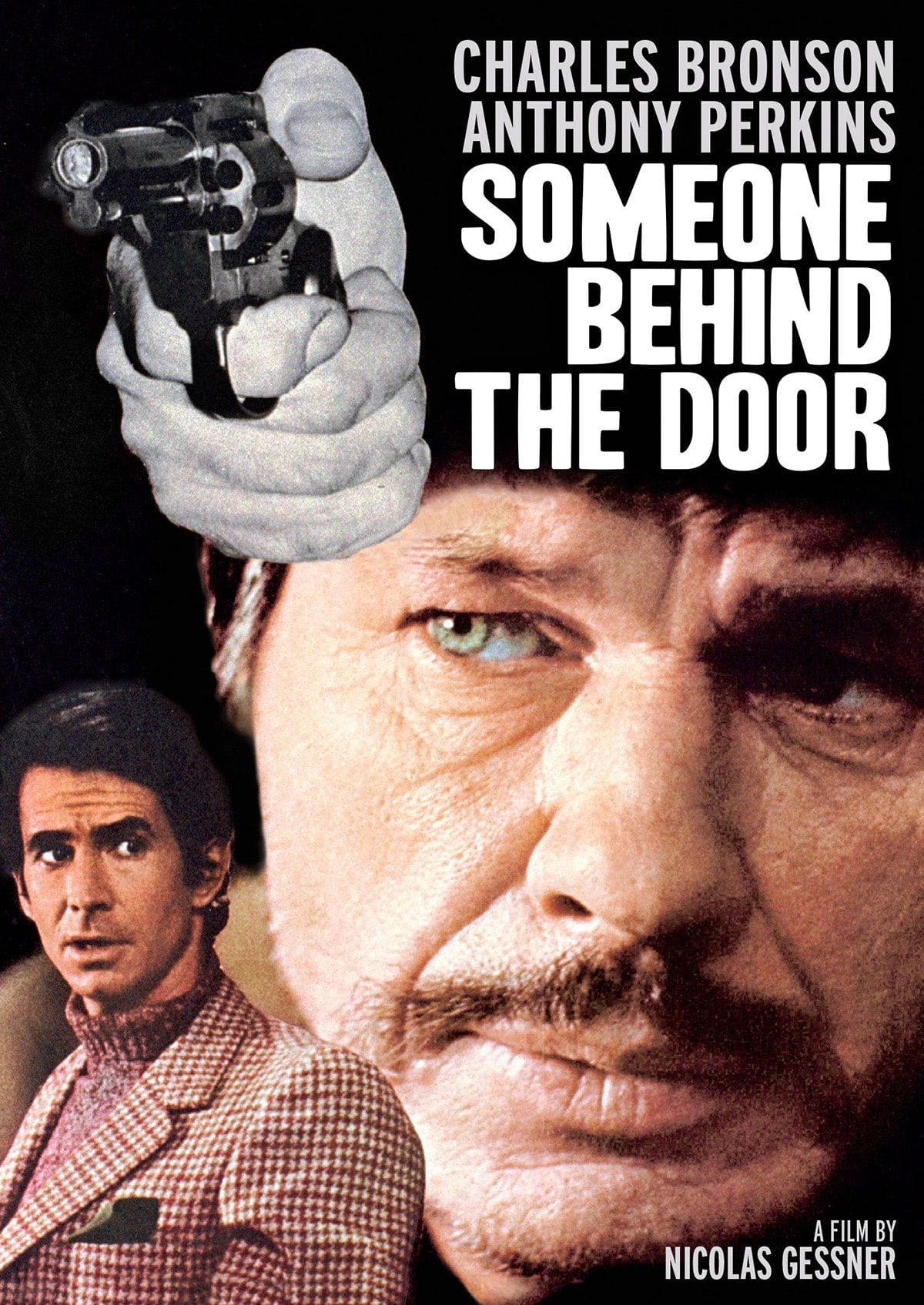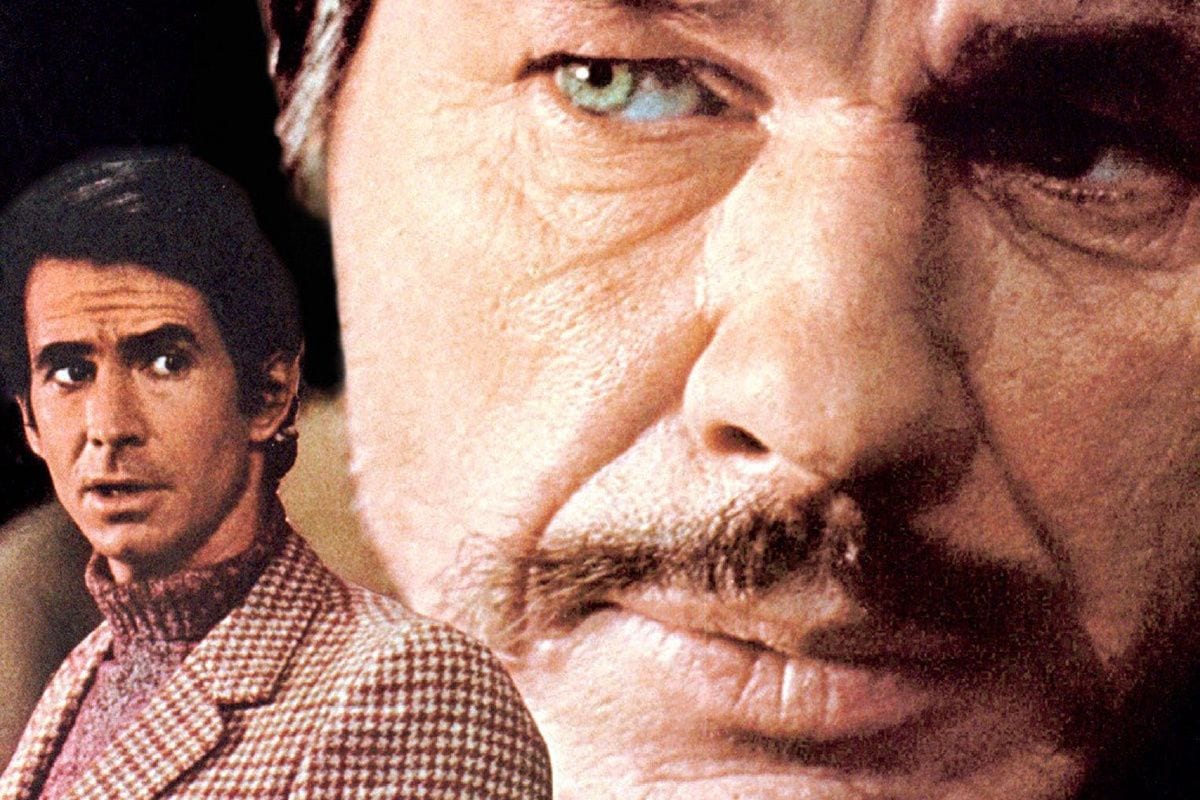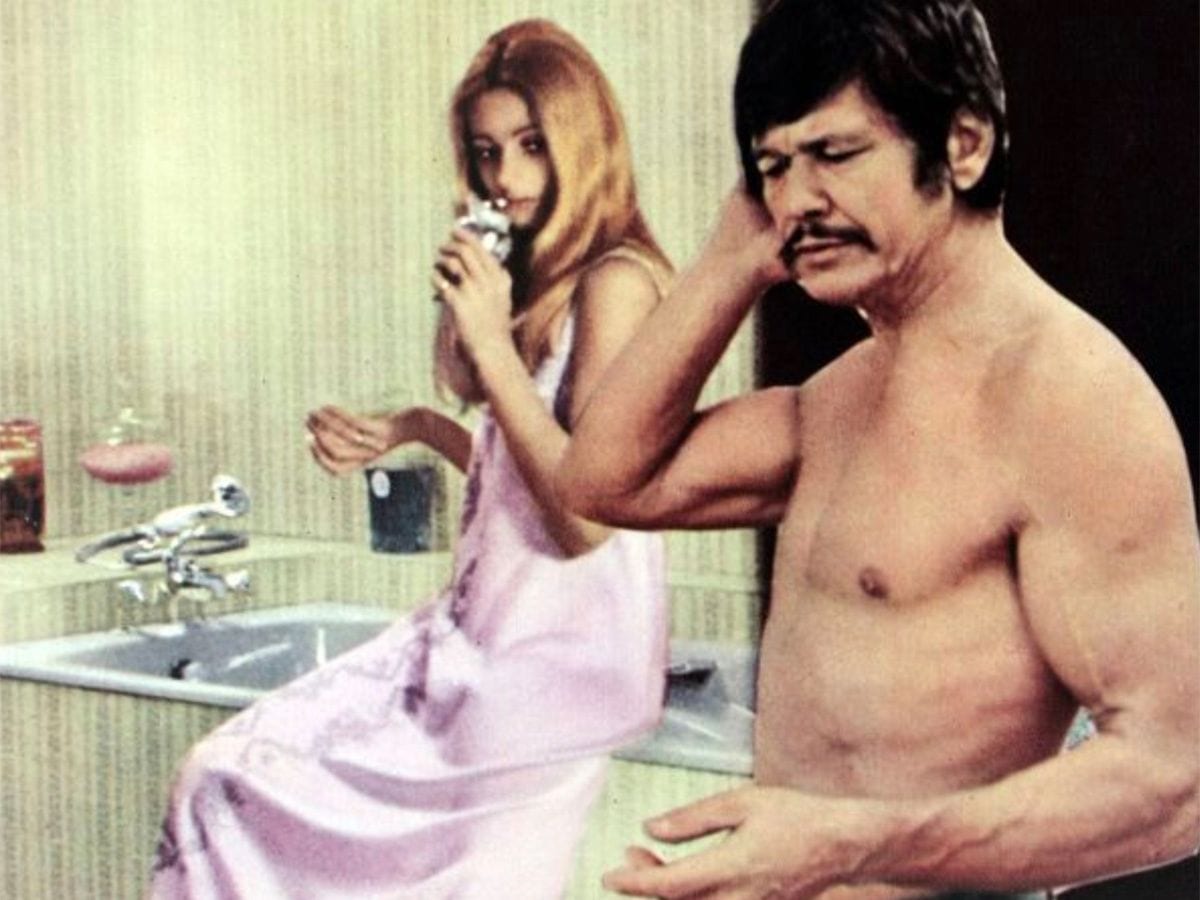
Nicolas Gessner’s Someone Behind the Door (Quelqu’un derrière la porte) (1971), now on Blu-ray from Kino Lorber, gives us one more intriguing, atmospheric puzzle from the career of a filmmaker whose works are little known in Region 1 or anywhere. He’s best known to film buffs and connoisseurs of suspense thrillers for the extraordinary, low-key 1977 film, The Little Girl Who Lives Down the Lane. Working mainly in France, Gessner has some 20 other films to his credit, sometimes for TV.
Someone Behind the Door is probably his second best-known thriller, thanks to its cast and having been shot in English, and now we have a chance to see an optimal presentation. This film unites Anthony Perkins and Charles Bronson, two very different figures in crime cinema, in an elegant cat-and-mouse story marked by suspicion and disorientation.
First we’re introduced to brain surgeon Dr. Laurence Jeffries (Perkins), masked and silent in a sequence marked by the rhythm of heartbeats, the noise of machines, and a patient known only by the marks on the back of a shaved head. Jeffries is established as a person more comfortable with the mechanical, perhaps even alienated from human emotions. He recoils when a nurse tries to massage him. He can relate to the backs of people’s heads, or to the eerily beautiful colored X-rays of their insides, more than their human faces and emotions.
We’ll learn that he’s only comfortable telling the truth to machinery, as he records his thoughts on a reel-to-reel recorder. He even states that memory problems fascinate him because “it’s like electronics”.
He emerges from a night of surgery, all tweeds and turtleneck in his stylish ’70s earth-tones and sheepskin coat, and spots an unresponsive, seemingly traumatized man in the waiting room, where he’s been brought by a cabbie who found him wandering on the beach in the English Channel town of Folkestone.
This unnamed man, billed in French as L’inconnu (the unknown), is played by a very subdued Charles Bronson, who had recently become a star of European cinema, thanks to Sergio Leone’s Once Upon a Time in the West (1969) and René Clément’s Rider on the Rain (1970). Bronson was on the cusp of becoming America’s biggest action star, but Gessner’s quiet psychological study is very different from the bulldozing violent scenarios for which he’d be known. There is, however, a gun in the story, and Chekhov’s rule that it must therefore be used is faithfully observed.
We get ahead of ourselves. First, Jeffries takes the man to his office for examination, noting the bright red scratches on his chest, and quickly establishes that he has amnesia and knows only something vague about a woman on the beach. That sounds sinister enough. Then a more quietly sinister detail emerges when Jeffries calmly tells a colleague that the man is simply drunk and wants to go to London, so Jeffries will drop him at the train station. The viewer knows this is a lie, and from this point we don’t trust Jeffries as he invites the unknown man to stay at his house for treatment, because amnesia is the doc’s specialty and that’s the kind of guy he is.
Most of the film takes place entirely at this house, with its chic interior design, so that the whole film could conceivably be a play except that Gessner and photographer Pierre Lhomme keep the style very cinematic. It’s claustrophobic only when dealing with the unknown man, who gets misled and boxed in under the guise of help. The viewer soon understands that Jeffries is grooming the man for some plan involving the doctor’s gorgeous willowy wife Frances (Jill Ireland, Bronson’s wife and frequent co-star). Frances tells her husband she’s going off to visit her brother, but he suspects she’s actually meeting a lover.
Even as the film allows us to put together snippets of information that head for a possibly inevitable climax, the film remains full of mystery, not only about what may happen but how it could be happening at all. The only way the story can make sense — and in a way that still makes no sense — is if we believe that, by wild coincidence, Jeffries has stumbled upon exactly the stranger he’d needed for a plan that must have been circulating in his brain. Everything in his plot is contingent upon taking advantage of exactly the peculiar circumstances provided by his “patient”, or guinea pig, on this very weekend. In this case, the fact that the plot has little or no logic, or that it stretches credulity after we analyze it, contributes to the puzzling, odd, sleek atmosphere that keeps us baffled while it’s going on.
Perhaps it’s impossible for such a premise to resolve itself to our complete satisfaction, and some viewers may feel the wrap-up is anti-climactic existentialism, much ado for a disappointment no matter how violent and tragic. And yet that disappointment is factored into the psychology of our anti-hero, Dr. Jeffries, who realizes that even a plan pulled off like clockwork might leave him empty and unsatisfied because he’s inherently empty and unsatisfiable. That’s not the sort of insight we expect in thrillers.
Jill Ireland and Charles Bronson in Someone Behind the Door (IMDB)
Anyway, the film really exists for us to watch Perkins and Bronson circle each other, Perkins flashing his semi-diabolical “I’m too clever” smile while Bronson evinces uncharacteristic befuddlement and frustration as a man who’s both a victim and, because of what we suspect of him, a potentially dangerous and unsympathetic person. If we judge a film by keeping us on the edge of our seat, it’s a success.
One notable stylistic detail is the music credited to Georges Garvarentz, which consists of a trumpet setting for the famous “Going Home” melody in Dvořák’s Symphony No. 9. It haunts the film, sometimes diegetically played as a record and sometimes only in memory. In the flashy closing moments, it’s layered over the opening heartbeat rhythms in a device similar to while different from the final credits of The Little Girl Who Lives Down the Lane.
That flashy visual device also recalls the final moments of John Huston’s Reflections in a Golden Eye (1967), which has something to do with an obsessive build-up to murder over an unfaithful wife. In that case, the hero’s heterosexuality was in question, and Gessner’s film, if one were to watch it without dialogue, would come across as a dream about a man, played by Perkins, whose disinterest in women leads him to “pick up” a stranger after removing his shirt and continually re-dressing him. He also displaces his wish-fulfillment personality onto the unassailable straightness of his patient.
Screenwriter Marc Behm, an American expatriate in France, is a cult novelist, especially in France, where he’s known for novels with a strange, confusing, semi-mystical air. His Eye of the Beholder (1980) has been filmed twice. According to his 2007 obituary in The Guardian, his novels’ “surreal and disturbing quality draws on such characters as an almost incestuous private detective, a bisexual woman preyed upon by the upper echelons of the Nazi party or a female vampire who traverses the 20th century.” In other words, he’s comfortable leaving his audience in a state of confusion.
As a film writer, he’s best known for the stories of Stanley Donen’s Charade (1963) and Richard Lester’s Beatles movie Help! (1965). He worked previously with Gessner on 1968’s The Blonde from Peking starring Edward G. Robinson and based on a James Hadley Chase novel. (And where’s that film, pray tell?) Someone Behind the Door is co-scripted with Gessner, Lorenzo Ventavoli and Jacques Robert from a novel by Robert, a crime novelist and scriptwriter.
Gessner’s commentary apologizes for “his accent” and says we’ll get used to it. While he’s no chatterbox, everything he says is a pertinent combination of practical background information and insights into how the film works. He says Friedrich Dürrenmatt told him good writing isn’t avoiding coincidence but making coincidence seem logical. Gessner points to how details and ideas are planted to come up later and help us suspend disbelief. He also explains that Robert’s novel was about a writer who met a man resembling himself who literally knocked on his door by coincidence. The screenplay makes them physically dissimilar and invents the brain surgeon detail, which makes more sense.
Please note that the movie includes a disturbing flashback of nudity and sexual violence, quite brilliantly edited by Victoria Mercanton, that would fetch an R rating today. In 1971, it was considered only GP (PG) material. Perhaps this is why the disc is now Not Rated.
Thanks to its star power, this film circulated on home video in the VHS era and has been known as Two Minds for Murder and Brainkill, while the French title (although the picture’s in English) is Quelqu’un derrière la porte. This good-looking Blu-ray only whets our appetite for Gessner’s more obscure titles. These include Tennessee Waltz (1989), a thriller reuniting him with writer Laird Koenig (of The Little Girl Who Lives Down the Lane) and starring Julian Sands and Rod Steiger, and 12 + 1 or The Thirteen Chairs (1969), which stars Sharon Tate (her last film), Orson Welles, Vittorio Gassman, Vittorio De Sica and Terry-Thomas in the very same Russian satire that was filmed by Mel Brooks the following year as The Thirteen Chairs. So much still to discover.
- Moral Ambiguity, Greyness and Imperfection in the Classic, 'Once ...
- Once Upon a Time in the West: Special Collector's Edition (1968 ...
- Honor Among Thieves, Jean Herman (film review) - PopMatters
- Let the Face Speak for Itself: Hard Features in 'The White Buffalo ...
- Charles Bronson: 'Rider on the Rain' and Cold Sweat' - PopMatters
- 'Psycho' and the Scene that Changed Modern Horror Forever ...
- Faintly Androgynous and Pathologically Disturbed - PopMatters
- Anthony Perkins in 'Psycho'
- Charles Bronson: 'Rider on the Rain' and Cold Sweat' - PopMatters
- Someone Behind the Door (Blu-ray) - Kino Lorber Home Video
- Someone Behind the Door - Wikipedia
- Someone Behind the Door by Miracle Pictures by Nicolas Gessner
- Someone Behind the Door (1971) - IMDb
- Charles Bronson - IMDb
- Charles Bronson (prisoner) - Wikipedia
- Charles Bronson - Wikipedia
- Nicolas Gessner — Wikipédia
- Nicolas Gessner - Biography - IMDb
- Nicolas Gessner
- Nicolas Gessner - IMDb
- Nicolas Gessner - Wikipedia


